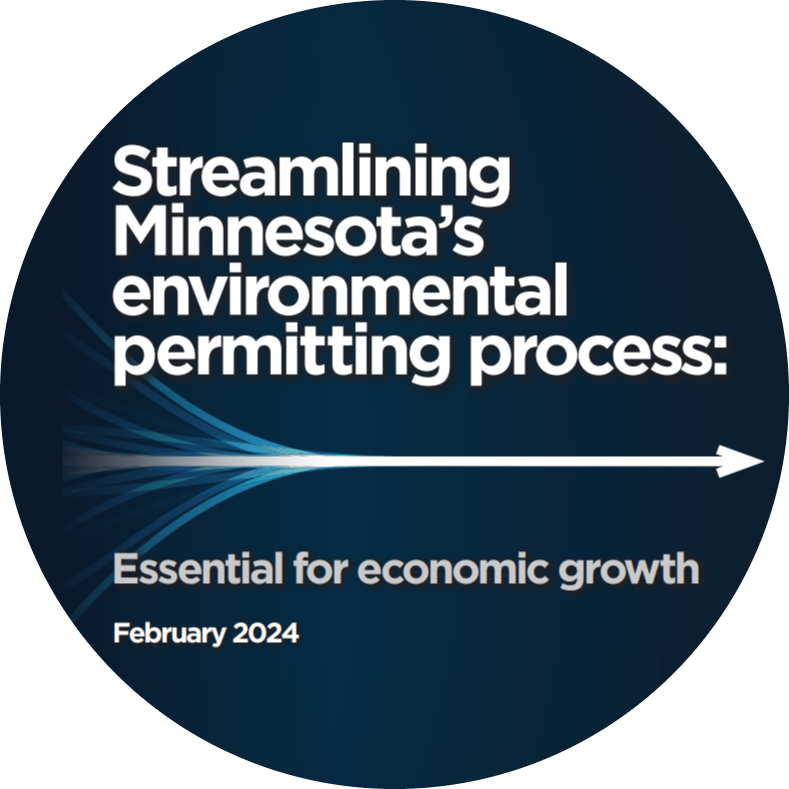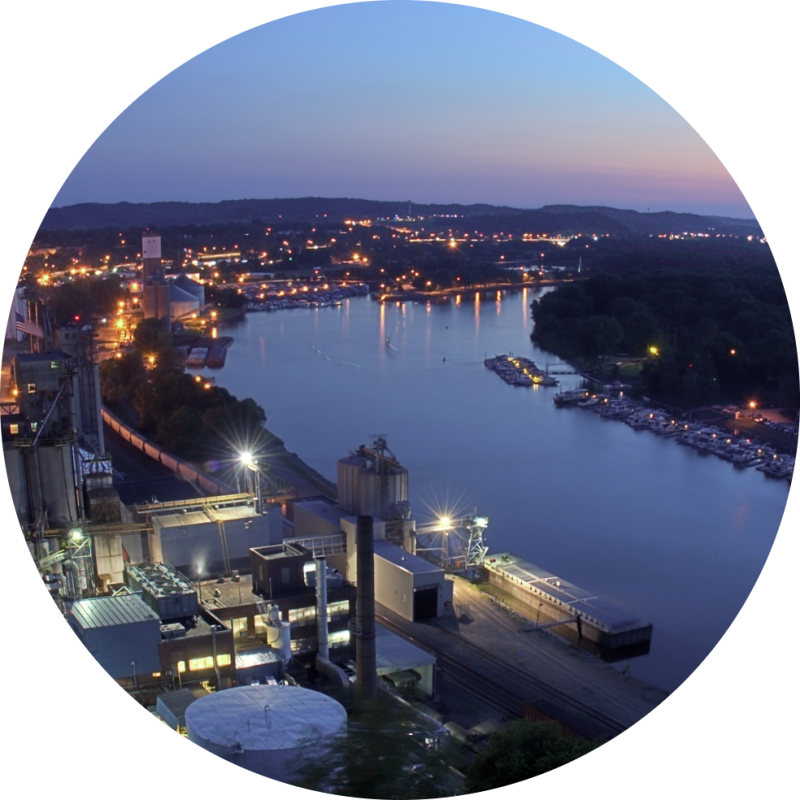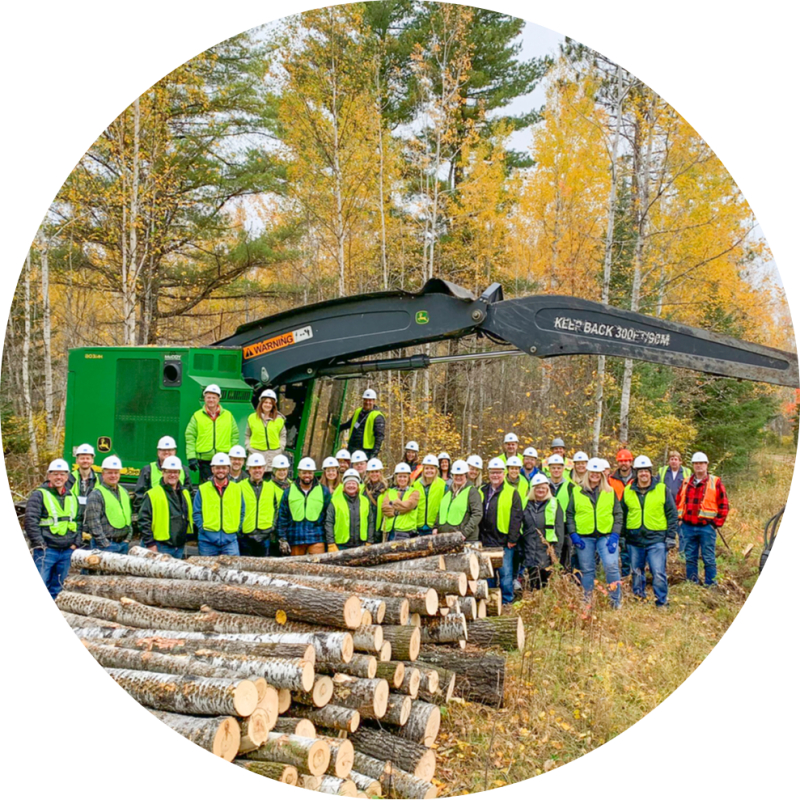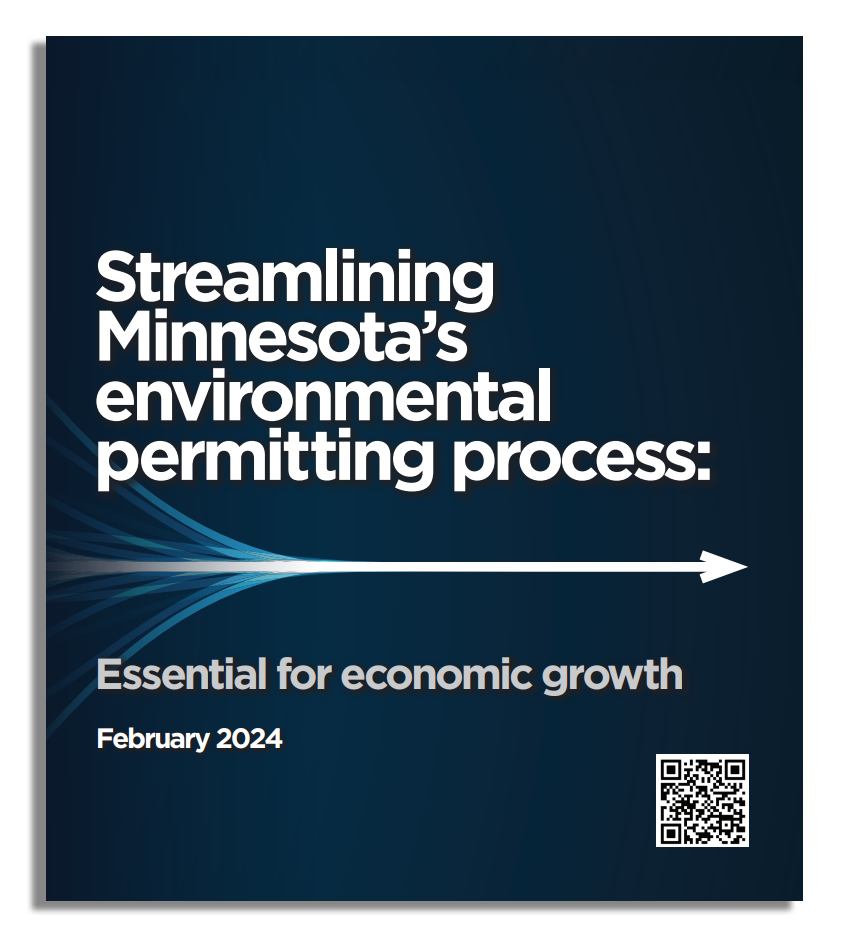Streamlining Minnesota’s environmental permitting process: Assessing timeliness and certainty
Time, cost and certainty matter for business investment.
The decision to build a new facility or expand an existing one is influenced by a variety of strategic and situational factors. Common to most decisions is the total cost, time and certainty involved with a new capital investment. These three factors are interrelated.
Delaying a project by 6 -12 months not only pushes back production and hiring but also can lead to substantially higher construction and borrowing costs, impacting the total project budget. Additionally, facing an unknown and potentially long time horizon increases uncertainty, making it difficult for businesses to predict and plan their facility and equipment needs with precision. One business interviewed by the Minnesota Chamber Foundation described how lengthy timelines to modify their air permit can hinder flexibility in their operations, forcing them to plan a year ahead of time for what equipment changes they may need.
Alternatively, when companies can predict their project timeline and gain approval in a reasonable timeframe, it can foster confidence in the firm’s decision to invest in a particular location.
How long does it take businesses to get an air or water permit or go through environmental review in Minnesota?
Answering this question is complex due to the wide range of permitting programs in Minnesota and the stark differences in typical timeframes across those programs.
To accurately assess the timeliness of Minnesota’s permitting programs, a few basic facts need to be acknowledged and understood.
A wide variety of permit programs
Minnesota agencies oversee and administer a variety of programs to regulate the potential impacts of facilities on the state’s air, water and land. This report analyzes timelines only for air and water permits issued by the MPCA and wetland programs managed by the Department of Natural Resources (DNR) and local governmental units (LGUs) due to data availability and applicability to economic development projects. Additional analysis is provided on Minnesota’s state-level environmental review program, which does not issue permits.
Each medium regulated by the MPCA also includes various permit types, ranging from simple registration and general permits to more complex permits that are written to cover the specific activities of an individual facility. In air permitting alone, there are twelve different permits that may apply depending on the facility’s emission types and levels.
Distinguishing between Tier 1 and Tier 2 permits
Permits issued by the MPCA are split into two tiers, with Tier 1 permits relating to less complex/lower emission facilities and Tier 2 permits relating to more complex and/or higher emission facilities. The standards and process are substantially more rigorous for Tier 2 permits. The MPCA has a goal to issue Tier 1 permits within 90 days and to issue Tier 2 permits within 150 days.
Overview of Minnesota environmental review and permitting programs
"Environmental review and permitting programs exist to contain impacts within reasonable and agreed-on bounds. Before development, the project’s overall impact is considered and weighed against its economic and social benefits. As the project is developed, the owners and operators receive permission to emit into the air or discharge into the water at levels informed by federal and local regulations. Those permissions take the form of permits to construct and operate a facility or project. If owners and operators exceed authorized emissions, they are subject to enforcement action and fines. This review, permitting and enforcement process is the backbone of environmental regulation and is
consistent across the United States.” – Barr Engineering
Priority and non-priority permits
The MPCA prioritizes permit applications based on whether the permit is needed for construction to take place at the site. Projects involving construction are deemed “priority” and those not involving construction are deemed “non-priority.” This is intended to ensure that projects with the most direct impact on economic development and job creation are issued faster.
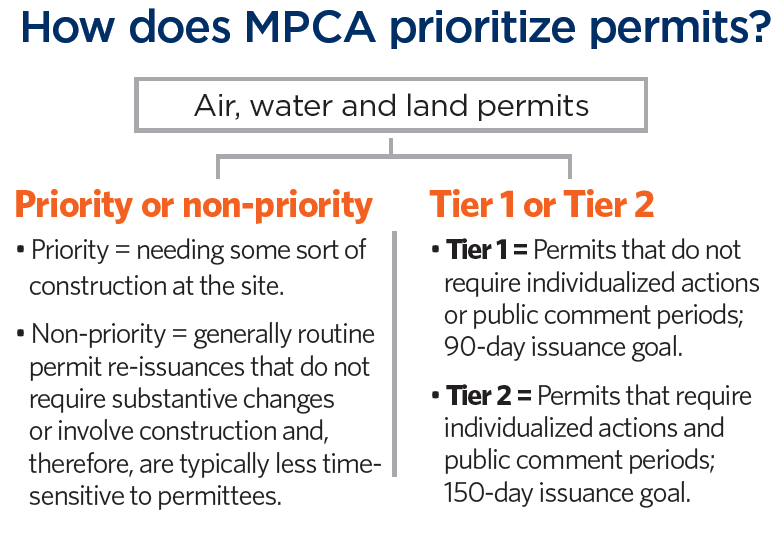
Most permits issued are Tier 1 water permits, skewing aggregate data
A large majority of permits issued by the MPCA are Tier 1 water permits, such as construction stormwater permits, that are usually issued within days. This means that aggregate measures of all MPCA permits will be overwhelmingly represented by these types and lower the overall statistics on timeliness. The MPCA issues an Annual Permitting Efficiency Report that documents timeframes for issuance of air, water and land permits received in the past fiscal year. While useful, this report has limitations that prevent a more complete and accurate assessment of permitting timeframes in Minnesota. These limitations – and some recommended changes to remedy them – are explained further in the full report prepared by Barr Engineering.
Minnesota typically issues Tier 1 air and water permits in a consistent and timely manner
An analysis of MPCA data show that the agency routinely issues Tier 1 air and water permits in a timely manner, consistently coming in well under the agency’s 90-day goal. This is especially true for “priority” Tier 1 permits that involve construction at the proposed site.
From 2018-2023, the median timeframe to issue priority Tier 1 permits was 29 days. In 2022, the MPCA issued 90% of all Tier 1 permits under its 90-day goal
The efficiency of these permit types provides clear benefits to low-emitting businesses who seek to expand or build a new facility. For example, one Minnesota business that proposed a new light manufacturing facility near the Twin Cities metro submitted its application and was issued a permit to construct and operate its new facility within 20 days. However, these types of permits are often not eligible for larger facilities and expansions.

There is no central, publicly available repository for environmental review documents occurring prior to May 2023.
Minnesota’s Environmental Quality Board (EQB) launched their Environmental Review Projects Database on its website that allows users to obtain environmental review documents for projects from May 2023 onward. The database does not provide summary statistics regarding timelines for projects to complete environmental review; however, statistics could be generated by manually extracting the information from each individual project listed when there is a more sizable dataset available. In addition, it appears that the EQB and other responsible governmental units (RGUs) do not maintain publicly available data that summarizes the timeline for the RGU to deem an environmental assessment worksheet (EAW) complete. This is an important step in the approval process and timeliness for approval can vary greatly.
Larger projects requiring a Tier 2 permit face substantial and persistent delays
Each year around 20-40 companies require a Tier 2 air permit to authorize a new project at or modification of their current facility. These often represent larger economic development projects, as the size of the project (i.e., facility size, number or size of equipment, production volumes, etc.) tends to result in higher emissions levels that trigger the need for one of the state’s Tier 2 permit types. The types of businesses that may need a Tier 2 permit range from pharmaceutical manufacturers and commercial bakeries to ethanol plants and large consumer goods manufacturers.
An analysis of air permits issued by the MPCA since 2018 shows that issuance of Tier 2 permits experience substantial and persistent delays.
The MPCA has a goal of issuing priority Tier 2 permits within 150 days of the agency deeming the application complete. But the average timeframe to issue priority Tier 2 air permits from 2018 to September 2023 was 586 days (nearly four times the agency goal), with the median being 351 days (over two times the agency goal). Further, businesses experienced a wide variance in timeframes, with some permits being issued in as little as 29 days and the longest priority Tier 2 permit taking 3,451 days to issue. This significant variation presents uncertainty to businesses, as the expected timeline to gain approval can range from less than a month to several years.
While less frequently requested, Tier 2 industrial water permits face similar delays as Tier 2 air permits. Barr Engineering found that the MPCA issued only 15 industrial National Pollutant Discharge Elimination System (NPDES) and State Disposal System (SDS) water permits since 2018. But of those 15, only three were issued in less than 150 days and those three that met the goal were for minor permit amendments. Issuance of new permits took an average of 476 days and major amendments took an average of 377 days.
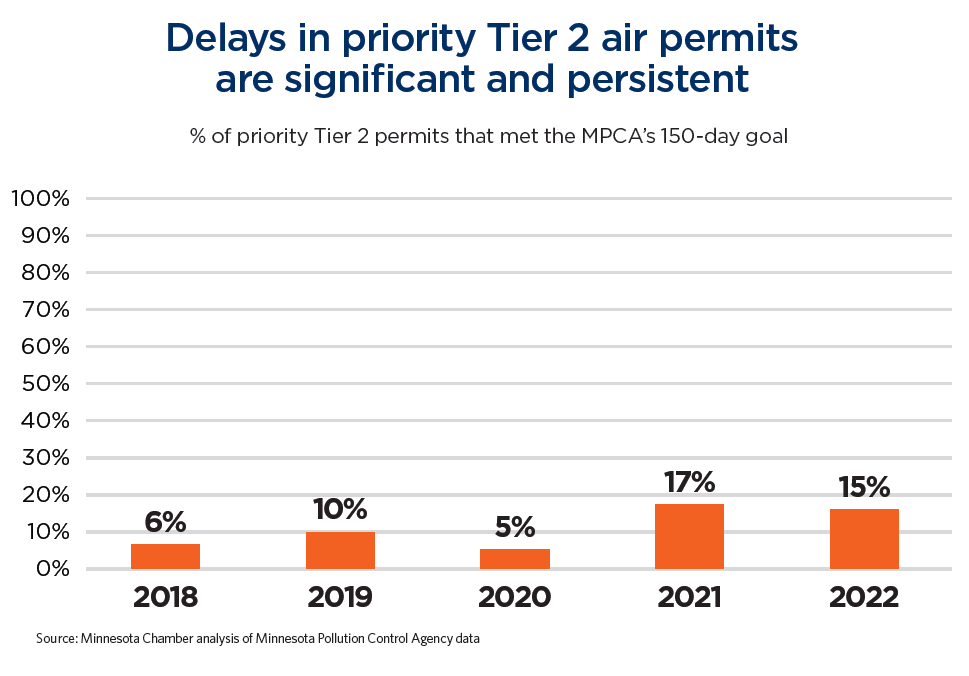
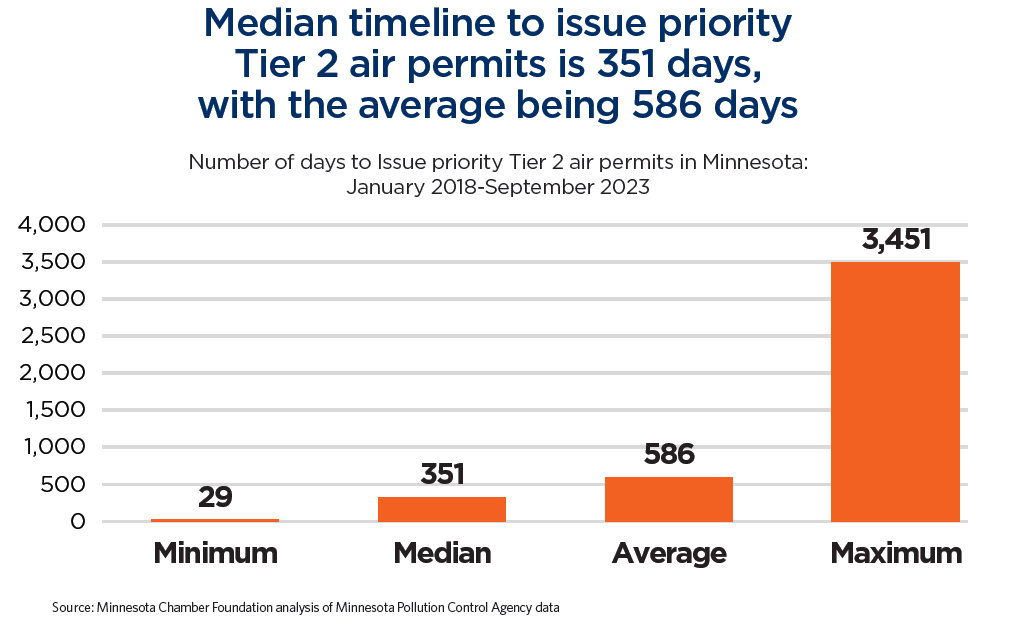
“Non-priority” Tier 2 permits can face years-long backlogs
While permitting timeframes can be significant for companies building or expanding facilities, the typical timelines for projects not involving construction are substantially longer, often taking years for companies to receive a permit renewal or modification.
The MPCA issued 339 non-priority Tier 2 air permits for Minnesota facilities from 2018 to September 2023. The average time frame to issue these permits was 1,295 days, with the median being 887 days. Timelines for Title V permit renewals were among the longest, averaging 1,476 days to issue.
Since non-priority permits don’t involve construction activities, they are typically less time-sensitive than priority projects. Additionally, current rules allow businesses to continue operating while they wait for a renewed permit to be issued, which lessens the impact of waiting times. However, excessive delays in non-priority permits can still be problematic for companies who want the assurance of operating under the full compliance of an active and up-to-date permit.
But the average timeframe to issue priority
Tier 2 air permits from 2018-2023 was
586 days (nearly 4x the agency goal),
with the median being 351 days
(over 2x the agency goal).
Projects requiring environmental review face months or years to complete, but lack of data prevents full analysis
Minnesota is one of twenty states or local jurisdictions that operate their own state-level environmental review programs. Like the National Environmental Policy Act (NEPA), Minnesota’s state environmental review program requires a designated governmental unit to gather information on proposed development projects that have the potential for significant environmental effects, and to provide information about the project to the public. These reviews typically occur through an EAW or Environmental Impact Statement (EIS), with the EIS process being reserved for projects with greater potential impacts. These reviews must be completed before the permitting processes begin for environmental permits, adding to project timelines.
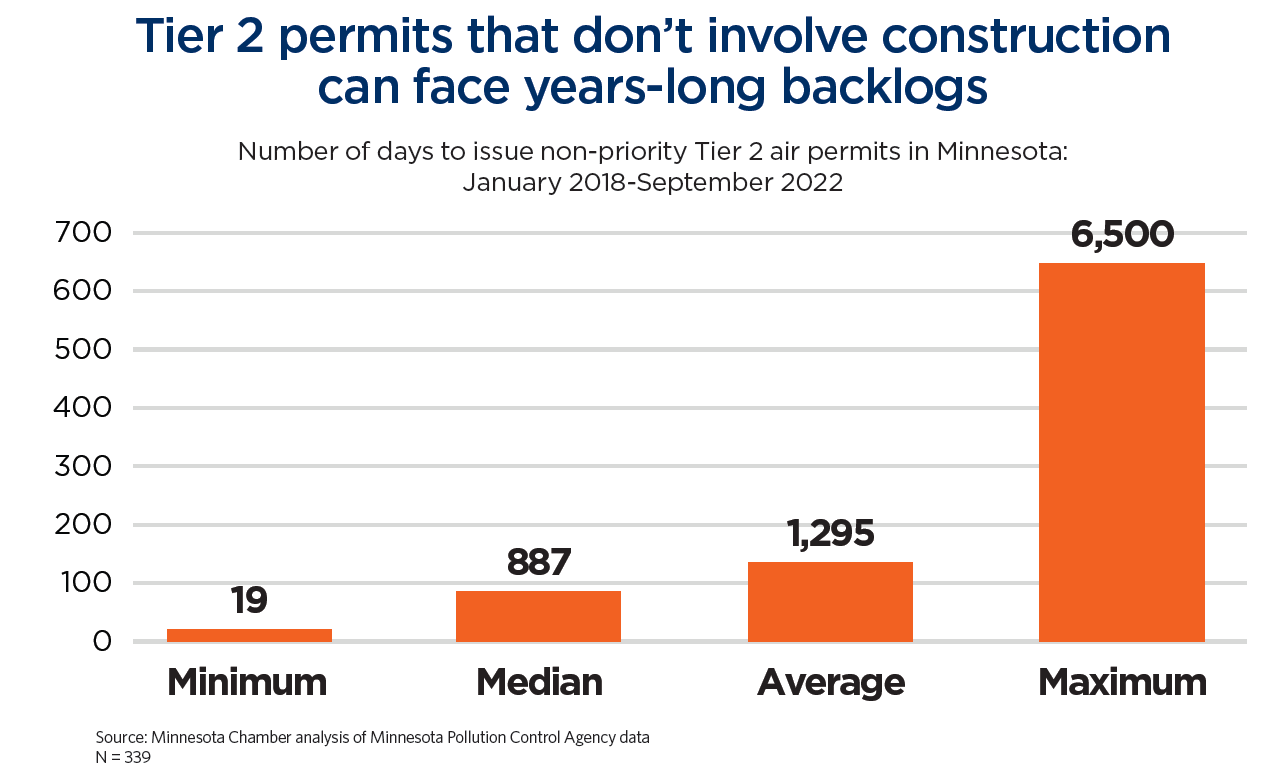
Unfortunately, local and state agencies do not publicly report the time it takes for individual projects to complete these important environmental review processes. This prevents external stakeholders – including policymakers and the public – from tracking the timeliness and performance of these programs.
The MPCA website states that EAW’s can take four to six months to complete and an EIS can take one to two years. However, regulatory agencies do not provide public data to confirm how often these timelines are met. Anecdotal evidence and past research from the Office of the Legislative Auditor (OLA) indicates that actual review times are often far longer than current guidelines suggest.
A 2011 report by the OLA, which reviewed a sample of environmental reviews from 2007-2010 found that EAW’s took anywhere from 39 days to nearly 800 days to complete. EIS reviews took even longer, with four of six private development projects analyzed in the OLA report exceeding two years. Environmental consultants interviewed by the Minnesota Chamber Foundation noted that timelines for EAW and EIS reviews continue to regularly exceed the agency guidelines, often taking multiple years to complete.
How do Minnesota’s permitting timelines compare to peer states? What is the economic impact of these differences?
To answer these questions, Policy Navigation Group (PNG) constructed a sample of air permits issued across seven states from 2017-2022, assessing how timelines differ between Minnesota and peer states. The permits included in the analysis were limited to federal air permits — rules for these permits are set by the federal Environmental Protection Agency but administered by state agencies — to provide an “apples-to-apples” comparison since the permit requirements are the same no matter where the facility is located. The only difference is in how each state reviews and processes the permits.
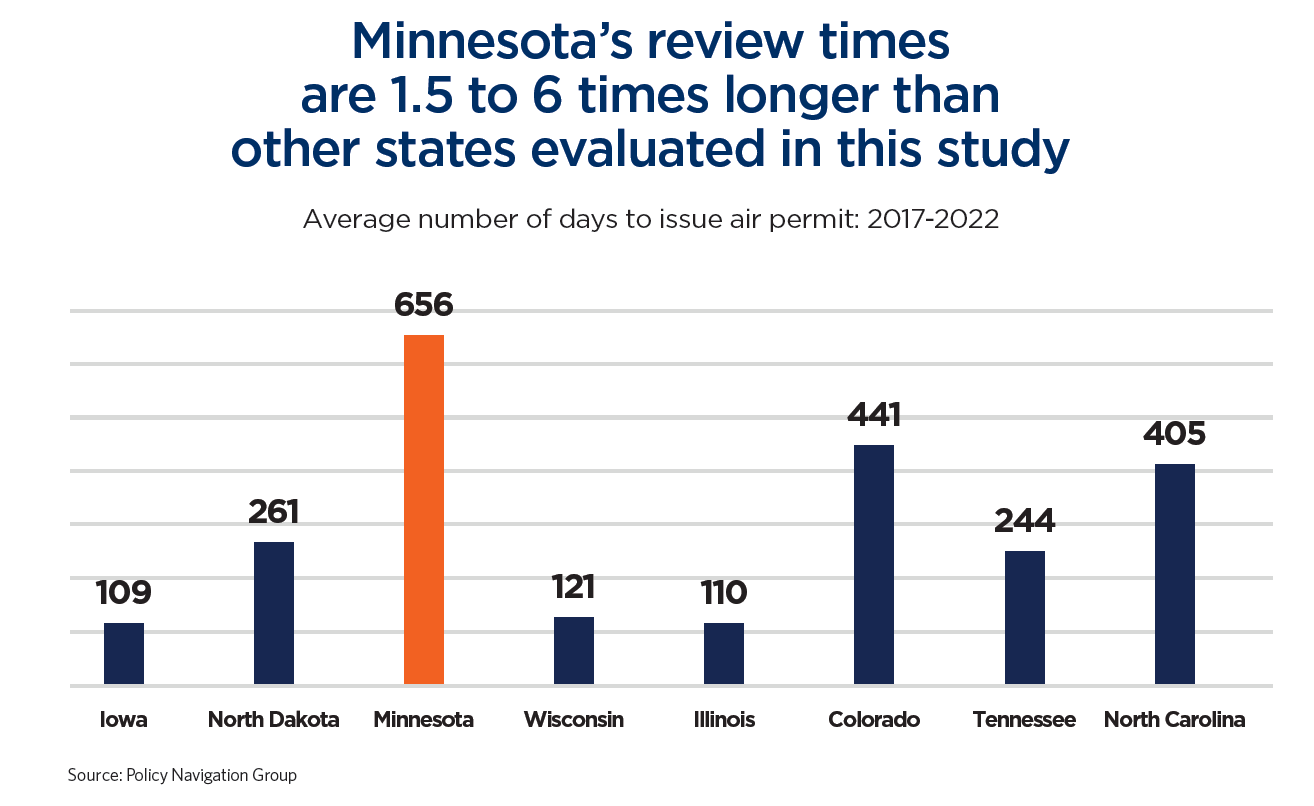
The sample includes only permits “triggered by new facility construction, new capital investments at existing facilities, and other significant changes” and is limited to facilities within certain manufacturing, agriculture and mining industries where Minnesota has a meaningful presence of activity (see full report for a complete methodology).
Minnesota’s air permitting review times are 1.5 to 6 times longer than other states evaluated in this study.
The findings from this analysis provided clear evidence that permit review times in Minnesota far exceeded surrounding states and peer states. Air permits issued in Minnesota took an average 656 days to review, compared to 109 days in Iowa (the state with the lowest average) and 441 days in Colorado (the state with the second-highest average after Minnesota). As summarized by PNG.
Data gathered from Barr Engineering indicate that agency staffing levels are not a likely explanation for differences in review times across states. Other states in this sample issue more permits per year at a faster rate than Minnesota despite having similar or fewer air permitting employees (see full report, sections 5.2.2. and 5.2.3.).
While this analysis includes a limited snapshot of permits issued in selected states, it provides meaningful evidence to understand how other states issue similar permits for large economic development projects.
Minnesota could achieve meaningful economic gains by reducing air permitting timelines.
Permitting delays have clear economic costs. When a new facility or expansion is delayed, it means fewer days of operation where businesses can produce goods, hire employees, purchase local supplies and services, and add revenue to the local tax base. The accumulation of “missed” days of operation across facilities and over time can add up to impact the state’s overall economic output, job creation and wages paid. PNG estimates that Minnesota could gain anywhere between $260 million to $910 million in annual economic output and 960 to 3,400 annual full-time jobs created if the state matched other peers in its air permitting review times for new and expansion projects.
PNG estimates that Minnesota could
gain anywhere between $260
million and $910 million in annual
economic output and 960 to 3,400
annual full time jobs created if
the state matched other peers in
air permitting review time.
Notably, this does not include the economic impact of projects that leave Minnesota or never come here at all because of real or perceived permitting challenges. For example, three projects – Huber, Talon Metals and Epitome Energy – which pulled out of Minnesota for other states due to reported permitting challenges – would have resulted in $1.3 billion in capital investments and over 300 jobs created. The PNG analysis, therefore, likely underestimates the total economic impact of the state’s current permitting performance.
What factors influence timelines and certainty in Minnesota’s permitting and environmental review processes?
Time matters to businesses in permitting decisions. However, transparency and certainty may be more critical to helping businesses plan new investments. Companies benefit from having clear expectations of what is required of them in the permitting or environmental review process, how long various steps of the process may take and how they can get guidance and updates from agency staff along the way. Findings from Barr Engineering – along with additional insights gleaned by the Minnesota Chamber Foundation in interviews with businesses and environmental consultants – identified numerous areas of Minnesota’s permitting process that can create bottlenecks and reduce certainty for capital investment projects.
Issues impacting time and certainty in Minnesota’s permitting process
Air permitting
Challenges in the initial application process: Before work begins on an air permit, the MPCA completes a thorough examination of the company’s permit application to determine if it contains all necessary elements for the agency’s technical review. Feedback from companies and consultants revealed frustration regarding this process, noting that simple application errors (such as missing information in a field) can cause the agency to reject the entire application, sending the applicant to the back of the queue to start over again. Notably, the agency’s 150-day goal for issuing Tier 2 permits does not start until after it deems an application complete. This initial step can add weeks or months to the permitting process, which is not reflected in permitting timeframe data. Other states in the region avoid this problem by either setting a time limit on the administrative review (Wisconsin and Iowa), assigning this task to nontechnical staff to check for basic completeness (Michigan) or skipping the step altogether (North Dakota).
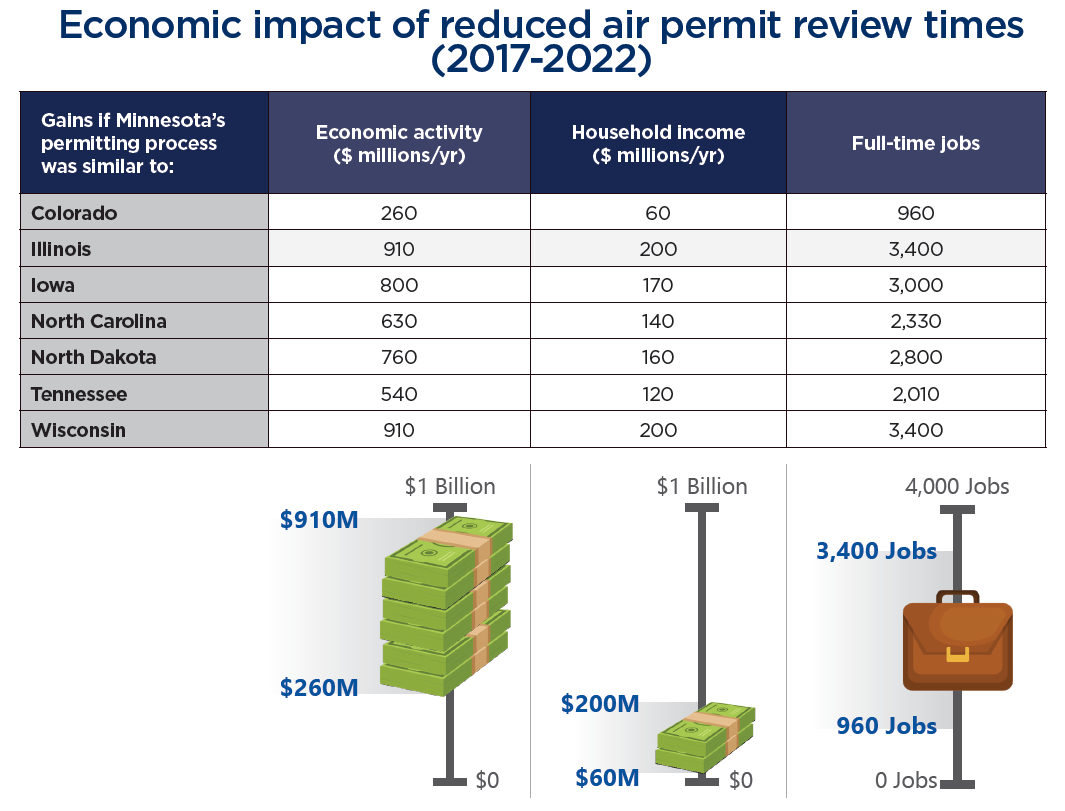
Delays in assigning a permit writer: Once the agency deems an application complete, it is assigned to a permit engineer who then begins the technical review process. Data from the MPCA’s “Air Permit Applications Received” dashboard shows that the time between the application being deemed complete and getting assigned to a permit engineer can often be more than 150 days. Many Tier 2 air permits exceed the agency’s 150-day goal before work even begins on the technical review of the permit. In 2022, the median timeframe that permits awaited assignment was 176 days. In 2023, the median time in the queue was 387 days.
Lack of a schedule to document permit review milestones and time expectations: One of the most important factors for businesses is being able to plan and predict what the permitting process will involve and how long the various steps will take. Feedback from permittees and consultants indicated that businesses typically do not receive a schedule at the beginning of the process, leaving them without the ability to plan accordingly.
However, this does not appear to be universal. One business interviewed by the Minnesota Chamber Foundation explained that their permit application was assigned to a permit engineer in less than one month after being received by the MPCA, and agency staff then provided a well-documented timeline and set of steps to help them plan accordingly. The business reported that this up-front knowledge improved their confidence in the process as they moved forward with an expansion at their facility. Programs like Minnesota Business First Stop have also sought to provide greater support and transparency by facilitating inter-agency meetings and direct communication to the business throughout the process.
Combining construction and operating permit programs may slow down the process: Many states issue construction air permits separately from operating permits, allowing the business to move forward with construction before their plans for operating the facility are approved. Minnesota, on the other hand, combines its construction and operating permits into one review process. There is some evidence that separating these permits could prevent delays for projects involving new or expanded facilities.
Air modeling and toxics review processes can create bottlenecks and lead to uncertainty: Barr Engineering notes that neighboring states avoid delays in National Ambient Air Quality Standards (NAAQS) air modeling and air toxic reviews, while Minnesota’s modeling can add time to the process. States like Iowa and Illinois (two states with the lowest permitting review times, according to the PNG analysis) allow work on the permit application to continue in tandem to modeling. Minnesota, however, requires modeling to be completed before work on the application can take place. Permittees in Minnesota also cited concerns about a lack of clarity during the air modeling process, noting that agency staff have the discretion to ask for further modeling without any defined limit on what will satisfy their analysis.
Minnesota’s permit structure and length can add complexity: The format and length of air permits in Minnesota can add complexity and impact businesses’ ability to understand compliance obligations. For example, Barr Engineering compared two similar facilities with Title V operating permits in Minnesota and North Dakota. These facilities are subject to the same federal regulations, yet there were large differences in how each state formatted and structured their operating permit. The Minnesota facility’s permit was 1,401 total pages compared to just 148 total pages for the North Dakota facility. Further, the North Dakota permit was more straight-forward, with clearly defined sections, making it easier for the business to understand compliance obligations. The Minnesota permit, by contrast, had overly homogeneous sections that created more complexity to navigate relevant information and compliance actions from the permit.
Companies often go through an intensive permit modification process to make minor or environmentally beneficial facility and equipment changes: Modifying an existing permit to upgrade equipment or make facility changes can add time and complexity for businesses. Over the past five years, major modifications for priority Tier 2 permits took an average of 493 days to issue. Minor amendments for priority permits took an average of 316 days. Timelines for non-priority permit changes were much longer, averaging over 1,000 days for major and minor changes. These lengthy processes can occur even for beneficial upgrades, such as replacing an older control device with a state-of-theart new device. Some businesses described ambiguity regarding how the agency interprets requirements for permit amendments. One business noted an example where their permit was changed from a minor to a major amendment due to differing interpretations between their original permit engineer and the new one to whom they were assigned.
Over the past five years, major
modifications for priority Tier 2
permits took an average of 493
days to issue. Minor amendments for
priority permits took an average of
316 days. Timelines for non-priority
permit changes were much longer,
averaging over 1,000 days for
major and minor changes.
Stakeholder interviews revealed a perceived culture of risk aversion, which inhibits agency decision-making: Stakeholders described that state regulatory agencies face a variety of pressures that may inhibit efficient decision-making, including the (real or perceived) threat of lawsuits from project opponents, criticism from community members about permit decisions or potential concerns over environmental impacts that went unevaluated during the permitting process.
Water permitting
Antidegradation review can add time to the permitting process without a clear set of expectations for the business: Minnesota adopted new antidegradation rules in 2016. As discussed in Section 5.2.1.2 of the full report, there is an indication that few permittees have navigated these antidegradation procedures successfully. It would be beneficial for the MPCA to consider opportunities to clarify and streamline antidegradation procedures such that the process can be less of a hurdle. Further review of the well-established procedures in Iowa, Michigan, North Dakota and similar states may help the MPCA identify more opportunities to clarify and streamline its antidegradation procedures.
Minnesota’s extensive list of water quality standards and impaired waters can be challenging to navigate: Compared to benchmark states evaluated in this study, Minnesota has far more individual water quality criteria than peers (1,355 compared to an average of 413) and lists nearly twice as many impaired bodies of water (though the state has a lower percentage of impaired waters as a share of its total waters). This extensive list of water quality criteria and impaired waters can create complexity for permittees and may require additional support to help businesses successfully navigate these requirements.
Wetlands
Overlapping authorizations: As described in the full report: “Minnesota has been exploring the potential to submit a request to the EPA to assume administration of Section 404 authorizations. Overall, this would reduce the number of overlapping authorizations required for wetlands except where the U.S. Army Corp of Engineers (USACE) retains jurisdiction. Only state agencies can be permitting authorities for an assumed Section 404 program; therefore, changes to state statutes and rules are necessary to gain approval from the EPA.”
No limit on time extensions by the LGU: While Minnesota typically processes wetland applications in a timely manner, there is a simple, commonly used procedure available to the LGU for extending the decision timeframe by an additional 60 days. There does not appear to be a limit on how many times the LGU can extend the decision timeframe.
Environmental Review
Minnesota has more extensive environmental review requirements than peer states: Minnesota is one of 20 states and local jurisdictions that have a NEPA-like environmental review program. Of the six peer states evaluated in this study, only Wisconsin and North Carolina have comparable programs. However, North Carolina’s program is used less frequently for private development projects, and neither state extends responsibility to local authorities or allows the public to petition an agency to require environmental review.
Minnesota is one of 20 states and
local jurisdictions that have a NEPA-like
environmental review program.
Current rules add redundant and unnecessary steps: Barr Engineering notes that in some cases, the EAW requires information on the project components that are covered more thoroughly in permitting documents, adding a step that will be duplicated if the project moves to the permitting phase. Additionally, project proposers are required to go through a prescribed scoping EAW even if the project is subject to a mandatory EIS. Since the scoping EAW, is intended to determine the need for an EIS, there may be alternative processes that could more efficiently handle these cases.
